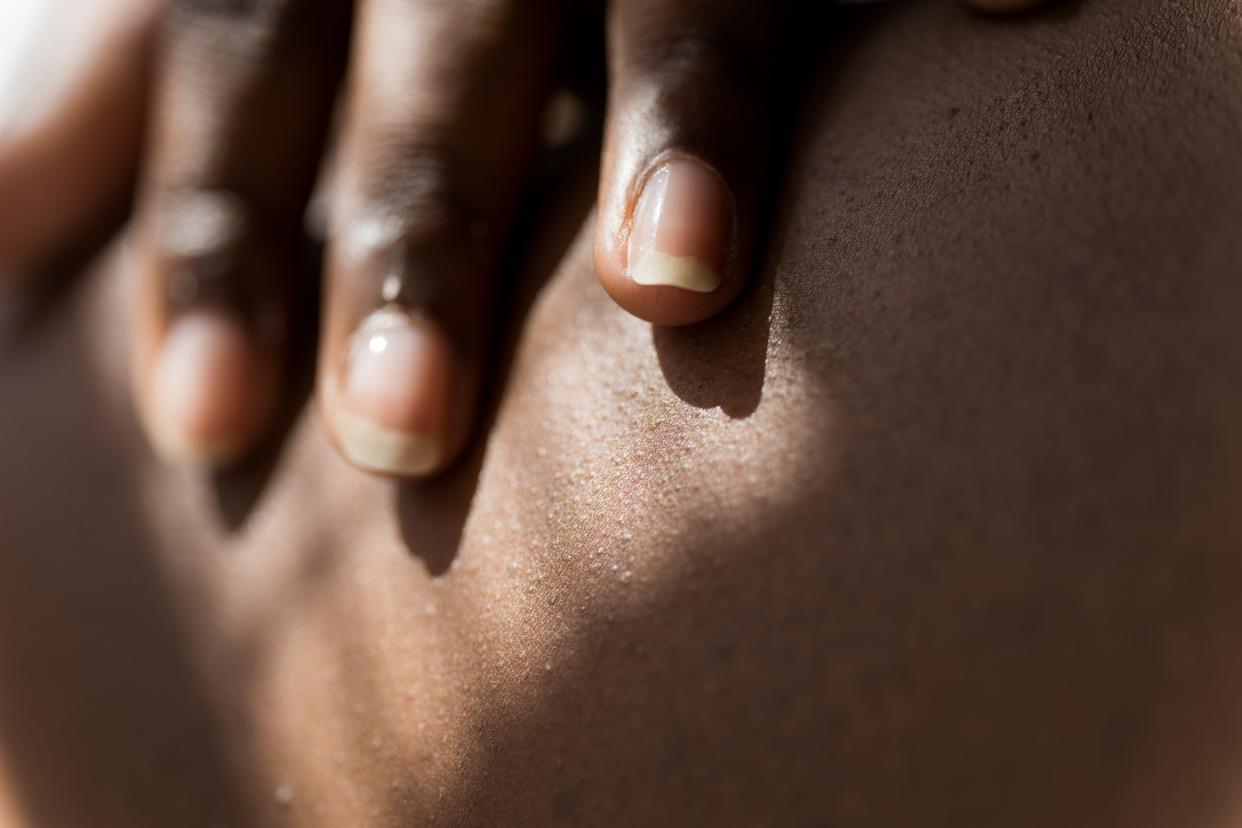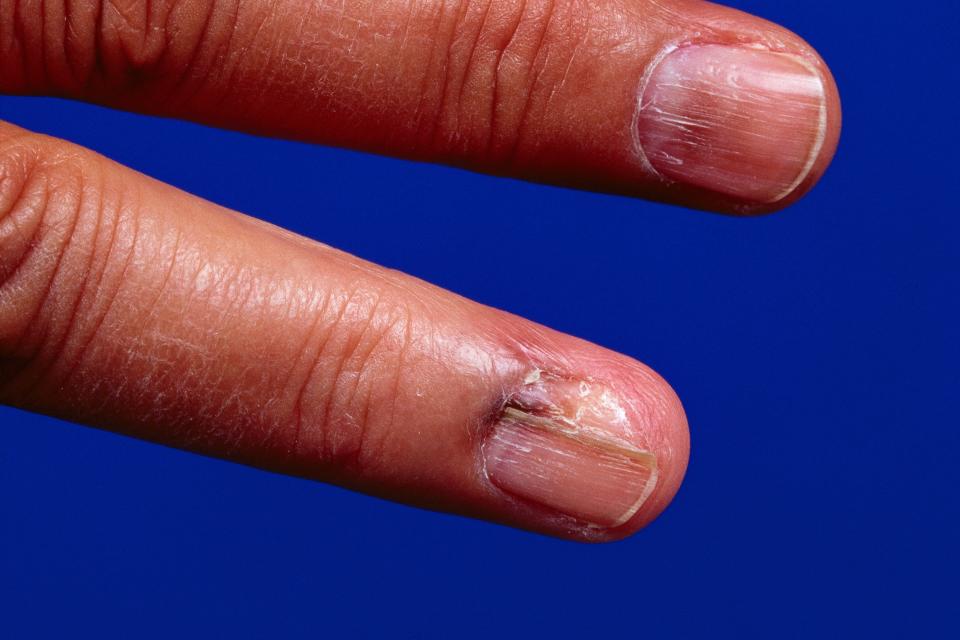5 Symptoms of Skin Cancer in Your Nails That Are Easy to Miss

Manu Vega/Getty Images
You’ve probably covered the basic things you can do to reduce your skin cancer risk: Wear sunscreen, avoid tanning beds, and get any suspicious moles checked out by a doctor. But no matter how diligent you may try to be about protecting every vulnerable inch of your skin, there’s one part of the body you likely overlook: your nails.
But wait, does that even count as skin? Nail melanoma actually starts in the nail matrix (the skin tissue underneath the nail plate, or the hard part that you might bite or paint with polish), Ife J. Rodney, MD, board-certified dermatologist and founding director of Eternal Dermatology Aesthetics in Fulton, Maryland, tells SELF. “This area contains melanin-producing melanocytes that give your nails their natural pigment,” Dr. Rodney explains. “But when these cells multiply uncontrollably, it can lead to melanoma, the deadliest form of skin cancer.”
Acral lentiginous melanoma (ALM), which encompasses all skin cancers on the palms of your hands, soles of your feet, and under or around the nails, accounts for only 2% to 3% of all melanoma diagnoses. When people talk about skin cancer in the nails specifically, chances are they’re referring to an even rarer subtype of ALM called subungual melanoma. (Sub- means under, and -ungual means nail.)
The good news is, this type of melanoma is highly treatable when you catch it early, Dr. Rodney says. But it can be tricky to spot, since the symptoms (which don’t resemble a sketchy-looking mole) are often only visible in later stages of the disease. So we asked two dermatologists to break down everything you need to know—including how to check your fingers and toes for major warning signs.
What causes nail cancer, exactly?
Surprisingly, excessive sun exposure isn’t thought to be the main cause of skin cancer in the nails, Michael Cameron, MD, founder of Cameron Dermatology and assistant clinical professor at the Mount Sinai Department of Dermatology in New York City, tells SELF. “It’s most likely due to genetics,” he explains. “The extent to which other possible risk factors, like ultraviolet (UV) exposure or repeated [physical] trauma, contribute is unclear.” (Research supports that people who have a first-degree relative with ALM have a higher chance of developing it themselves.)
Evidence also shows that subungual melanoma is the most common variant of malignant melanoma among Asians, Hispanics, and African Americans (it represents a whopping 75% of melanomas diagnosed in Black people). Dr. Cameron explains that this doesn’t necessarily mean race or ethnicity alone will increase the risk: “It may just indicate that people in these groups don’t get other, more common melanomas as often as fairer-skinned people do.” (Worth noting: It’s a total myth that you shouldn’t worry about skin cancer if you have a deeper complexion. While it’s true that Black people are less likely to get melanoma in general, they have a much higher risk of dying from the disease than folks with lighter skin, and several complex factors might contribute to this racial disparity).
As for certain lifestyle habits? Some researchers theorize that regularly getting gel manicures (which require UV lamps to dry the polish) might increase your risk of the two most common forms of skin cancer: basal cell carcinoma and squamous cell carcinoma. But as SELF previously reported, there aren’t enough long-term studies that look at the skin-damaging effects of these lamps to confirm a cause-and-effect connection.
How to check for signs of nail melanoma
According to the dermatologists we spoke with, nail melanoma can initially have no symptoms at all. “That’s the scary part,” Dr. Rodney says. “You may not have any pain, discomfort, itching or anything”—which is why the American Academy of Dermatology (AAD) says it’s crucial to be vigilant and keep an eye out for these warning signs (in both your fingernails and toenails):

Malignant Melanoma
BSIP/Getty ImagesA dark line in the nail: More specifically, the AAD says it can appear as a vertical brown or black streak—usually just one, not multiple. “This would look different from a hematoma, a dark reddish glob under the nail that’s circular or round, not a linear stripe,” Dr. Rodney says.
The line widens in shape: “If you notice the stripe is growing or getting thicker, that’s cause for concern,” Dr. Rodney says. If melanoma is at play, these changes suggest that “melanin-producing melanocytes in the nail matrix are multiplying.” (Meaning, the cancer is growing.)
Darkened skin around the nail: This could be a symptom of advanced melanoma called a Hutchinson’s sign, which indicates that the cancerous cells have spread from under the nail to surrounding tissues (like near the cuticle or nail fold), Dr. Rodney says.
Nail splitting: Sometimes, the discoloration can progress to thickening or cracking of the nail plate, which can be painful.
Nail lifting: In more severe cases, melanoma can lead to onycholysis, or when the nail plate completely separates from the nail bed.
Of course, these symptoms don’t automatically mean you have skin cancer. Less concerning things like repeated trauma to the nail from activities like long-distance running, chronic nail picking and biting, or fungal infections like onychomycosis can trigger similar discolored lines, per Dr. Cameron. (And that’s why it’s always worth seeing a medical professional for an accurate evaluation.)
How is nail cancer treated—and what can you do to prevent it in the first place?
If you notice any of these symptoms affecting your fingers or toes, try to see a board-certified dermatologist or primary care provider (who can refer you to a derm) ASAP. A doctor can take a closer look and determine if you need a biopsy, a simple procedure that involves removing a sample of the skin and sending it to a lab for testing.
You can’t really “prevent” things like a family history of melanoma, but one change you can make to up your chances of protecting yourself is limiting how often you get gel manis and pedis. (Dr. Rodney recommends one appointment every two to three months.) While you’re unlikely to develop skin cancer this way, the derms we spoke with say it’s always smart to minimize direct UV exposure. In fact, applying a nickel-sized dollop of broad-spectrum sunscreen (SPF 30 or higher) on each hand or foot before hanging out in the sun (or even before your nail appointments) can significantly decrease your melanoma risk, per the Skin Cancer Foundation.
“Early detection is key for this rare yet dangerous type of skin cancer,” Dr. Cameron says. Simply being aware that nail melanoma exists—and regularly scanning your body for suspicious marks—can go a long way in keeping your skin healthy.
Related:
A Lump in My Groin Led to a Stage 4 Melanoma Diagnosis When I Was Just 22
I Finally Found a Water-Resistant Face Sunscreen That Also Makes My Skin Look Great
Originally Appeared on SELF


